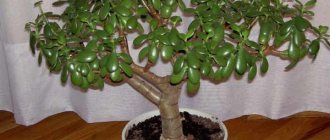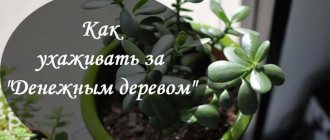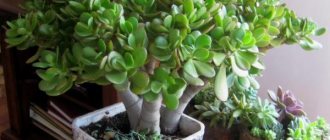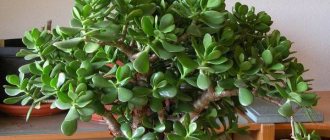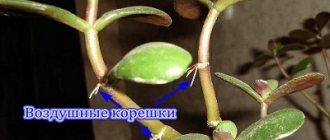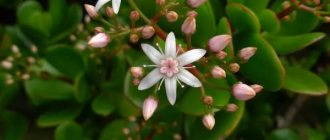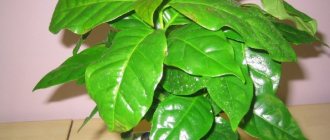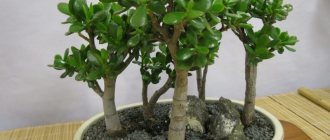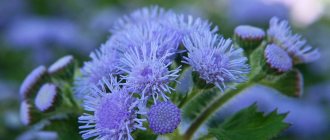Home » Flowers and plants
Vladimir 11/20/2017
10881 View
Today, almost every housewife grows a money tree at home, but not everyone knows how to properly care for it and what features are characteristic of this plant. This is exactly what we will talk about.
Where did this name come from?
Crassula is a plant native to Madagascar. This is a deciduous ornamental tree, some species of which can bloom, although this happens extremely rarely at home. Considering the climate of this plant’s homeland, it can be left without watering for a long time. A sufficient amount of moisture collects in the leaves of the fat plant, which helps the plant “survive” without watering.
Many people know this plant as money tree . Why money? Crassula leaves strongly resemble coins, hence the name. This is what made Crassula a “bait” of wealth.
Minor grade money tree seedlings
Many housewives firmly believe that a fat woman placed according to Feng Shui can attract wealth and prosperity to the house. The pot with the flower should be placed on the eastern or southern window, and its branch should be tied with a red ribbon. According to legend, it is in the fleshy leaves that all the wealth accumulates, and the more branches, the more leaves on the tree, the richer the house becomes.
Scientific and popular name
The name “money tree” is not the only one received by the people. This plant has long evoked a variety of associations in people. The origin stories of the name are of particular interest.
Crassula names:
- Money Tree. The plant owes its original name to its thick, rounded leaves that look like coins. There is a popular belief that if you have a money tree in your house, it will attract almost all earthly blessings: happiness, finances, good luck. It is believed that the plant has a special energy that eliminates negativity and attracts positive events. For the first time such properties were attributed to the fat woman in Ancient China.
- Monkey tree. Only primates can reach the leaves growing on the tops of plants. Monkeys get them to drink the water stored in them.
- Jade tree. In the east, jade is considered the stone of youth. It gives power, happiness and longevity. The poor could not buy such a stone, so they had to be content with a plant whose leaves resemble jade.
- Jadeite tree. The name was received for its resemblance to a mineral that brings power and wealth to the owner. It is believed that jadeite improves the human biofield and relieves emotional overload.
Crassula is also called the African tree, the tree of happiness and love. There are other options, but they are not as common.
On a note! In Feng Shui, it is believed that the money tree is capable of “attaching” to its owner. It actively grows if everything is good in the house, but if there is negativity, it begins to wither, drawing evil onto itself.
The scientific name of Crassula is practically not used by people. Biologists know this plant as Crassula, which translates into Russian as “fat.” “Money tree” is scientifically called Crassula ovoid or oval - Crassula Ovata.
Secrets of plant care
Although this plant is not picky in its care, for it to “prosper” you need to create favorable conditions.
To do this, just follow a few simple rules:
- In its homeland, Crassula grows in well-drained soil, which can easily be made at home. Sand, peat and soil should be mixed in a ratio of 3/2/2.
- Flowerpots for this plant are filled with this mixture.
- There must be drainage at the bottom of the flowerpot, about 2 cm thick. The pot should not be deep, clay or plastic
- The plant should be placed in the shade; Crassula likes to grow in the shade, where the plant will develop better. If the plant is exposed to direct sunlight, it begins to dry out, turn red and fall off.
- The ideal temperature for Crassula is 15-20, but it can withstand 30 degrees just as well. Although the plant can tolerate +5 well, being in a colder environment will lead to the death of Crassula.
Watering a money tree should be considered separately
It is important to remember that you only need to water it when the soil is a little dry. Water it abundantly, but not often. Because of its origin, the fat plant does not like excessive humidity.
If you overwater your money tree, its root system will begin to rot and the plant will die. Care must be taken to ensure that water does not get on the leaves of the tree. In summer and spring it needs to be watered more often than in other seasons.
In winter, the plant is not afraid of the soil drying out even 5 centimeters deep. This is due to the state of rest with the onset of cold weather. At this time, the leaves of the fat plant accumulate the maximum amount of moisture and tolerate such a “drought” without problems.
It is also necessary to monitor the quality of water for irrigation. Settled or melt water with a minimum amount of impurities is suitable for the plant. It is equally important to maintain the liquid at room temperature. The most experienced housewives recommend wiping the dust from the leaves from time to time and spraying them with a spray bottle.
Possible landing options
Planting a money tree in a separate pot is just one of the possible options. Crassula grows well in a florarium and in a “garden in a bowl.”
Money tree in a home florarium
To plant a money tree in a florarium, you will need a special earthen mixture for succulents and charcoal. Being in a confined space provokes rotting of the roots, and coal allows you to disinfect decaying organic matter.
Crassula looks great in a florarium
Succulents in a florarium should be watered sparingly. Crassula does not like excess moisture, and in a sealed container there will be nowhere for water to evaporate.
Important: do not forget to open the closing florarium for fresh air.
How can Crassula be placed in a “garden in a bowl”
Hardy crassulas are the best option when creating a miniature garden from living plants. This species has about three hundred plants. Many have leaves that are original in color and shape, which give unusual combinations. Having prepared everything, as with the usual planting of a money tree in a pot, begin to plant several types of succulents in a flat container. Such a miniature composition can be moved from place to place and requires minimal maintenance. A “garden in a bowl” made from several stems of a money tree can be placed not only on the windowsill, but also on a coffee table, shelf or computer desk.
Crassula is used very often in such compositions.
How to transplant a Crassula correctly
The plant needs to be replanted once every two years, but not more often, because this plant grows for a long time. Spring is the best time of year for this. But it is important to carry out the replanting process correctly, and to do this, just follow the following instructions:
- At the bottom of the pot you need to make a drainage of 2 cm. After this, the pot is filled 1/4 with substrate. According to legend, in order to attract money and positive energy into the house, you need to put a couple of coins at the bottom of the pot, but this is purely optional
- The plant must be carefully removed from the old flowerpot, while holding it by the main trunk. The soil from the roots needs to be shaken off and the money tree placed in a new flowerpot. After this, we fill in the soil.
The process of clearing the roots of old soil during replanting
The soil should settle on its own; there is no need to trample it down immediately after replanting. The soil is then added as needed.
- The last stage is to water the plant. After replanting, the soil in the pot needs to be loosened from time to time so that oxygen can penetrate to the roots. And, accordingly, water it
Varieties and varieties
There are many varieties of this flower, bred by domestic and foreign breeders. As a rule, they differ in the shape and color of the leaves, as well as the height of the adult plant and life expectancy (which can be quite long with proper care). Most often, domestic gardeners grow the following species at home:
- with dark green leaves;
- with variegated leaves (mosaic pattern);
- with slightly curled leaves.
Not only the appearance, but also the characteristics of care depend on the variety. Some species are more vulnerable to diseases and pests, while others are more resistant; the same can be said about the requirements for fertilizing and soil moisture.
With green leaves
These plants have smooth, dark green, ovoid, slightly glossy leaves. The most popular varieties among domestic amateur gardeners are:
- Monique;
- Exotic;
- Anastasia;
- Dunetti.
They are quite sensitive to lack of moisture, but have good immunity to diseases and common pests.
Nicole
This is one of the shortest varieties, so it is recommended to grow it in small apartments where a tall plant with a branched crown will not fit. The leaves are dark green, glossy on the outside, their length reaches up to 6 cm. The leaves have an oblong ovoid shape, curve along the vein and are smooth at the edges.
Daniel
It is an evergreen plant that belongs to the mulberry family. The homeland of this variety is the Australian tropics. At home it grows up to two meters, and in nature – up to 30 meters inclusive. The glossy oval leaves are smooth along the edges and in the middle, their length reaches 5 cm. In a young plant they are light green, but darken with age.
Monique
This ficus grows quickly, the shoots are long and thin; If young growth is not trimmed in time, it bends and breaks. The lower leaves fall down in beautiful waves. The leaves are 5–6 cm long, glossy, dark green, with a pronounced convex vein in the middle.
Exotic
The height of an adult plant is 1.5 meters. The leaves are wavy at the edges and straight inside, dark green. A correctly formed crown has a pronounced spherical shape.
Anastasia
This is the most light-loving variety; it quickly withers in the shade. If the lighting is sufficient, the flower can grow up to 1.8 m, and the leaves reach 7 cm in length; if there is little light, the leaves become smaller and dry out. The dense, fleshy, dark green leaves are glossy and elliptical in shape.
Dunetti
The height of the plant is up to 3 m; under the right conditions, ficus often blooms, but the flowers are small and pale. The plant has a dense crown that requires regular pruning. The leaves are 5 cm long, fleshy, dense, light green.
Moklame
This variety has many aerial roots, the leaves are 6 cm long and have the shape of an ellipse. The height of an adult plant can reach 3 m if there is enough light in the room. The bark is gray and loose. The plant requires feeding.
Variegated (variegated)
These varieties look especially beautiful. Their leaves seem to be decorated with multi-colored mosaics that form intricate patterns. The most popular varieties:
- Twilight;
- Nina;
- Safari;
- De Gantelle.
These varieties require regular feeding. The pattern on the leaves may lose its original appearance due to fungal and viral infections, diseases and pests. To restore the shape of the leaves, the flower must be sprayed regularly.
Starlight
This is a plant of the mulberry family, the foliage has a beautiful mosaic marbled coloring that resembles marble. White spots stand out effectively against a dark green background. This is a unique color. However, this variety has a drawback - slow growth, only 10 cm per year.
Safari
Compact, low-growing variety, suitable for small apartments. The leaves are 4 cm long, separated by a vein, have a slightly curved shape, and marbled yellow-white spots are randomly scattered on them. In low light, the foliage turns yellow and growth slows down. For normal development, an additional source of lighting is required - a lamp.
Nina
Compact miniature variety, leaf blades are dark green in color, marbled white-yellow edging. The smooth, dense leaves reach 13 cm in length; each leaf has up to twenty lateral veins and one central one. In summer, small inedible berries appear on the plant.
Reginald
A tall variety, under good conditions can grow up to 3 m. The leaves are light green, with dark green small mosaic patches in the center, the leaves are 10 cm long. The bark is light gray, dense. The variety is unpretentious, but is afraid of drafts and cold.
Golden King
A distinctive feature of this variety is its shiny bright green leaves with a yellow stripe along the edges. In nature they grow up to 30 m in height, at home they can stretch up to 3 m, but with a lack of lighting the flower begins to grow very slowly. This variety is demanding on feeding and loves soil rich in nutrients.
De Gantelle
The leaves are elongated, heart-shaped, reaching 12 cm in length and 3 cm in width. The crown is dense, branched, and, when formed correctly, has the shape of a ball. The leaves are very light, almost white, but with dark green stripes. The plant is quite unpretentious in care, but due to the rapid growth of the root system, the ficus will have to be replanted frequently.
Twilight
The calling card of this variety is the leaves of a noble dark green color with a white edge. The contrast of white and green looks very impressive and immediately attracts attention. The plant can stretch up to 2.5 m with sufficient lighting and good watering. The central vein of the leaf is almost white due to the small amount of chlorophyll. The leaf length does not exceed 7 cm, most often up to 6 cm. The petioles are 1.5 cm long and dense and fleshy. The plant loves slightly acidic soils and does not tolerate nutrient deficiencies and lack of moisture. It is often affected by diseases, but is relatively resistant to the main ficus pests - scale insects, aphids and mites.
With curled leaves
These varieties require abundant and regular feeding. Due to a lack of nutrients, the negative impact of diseases and pests, and lack of moisture, the leaves can become deformed and lose their spectacular appearance. Most often, domestic lovers of indoor floriculture grow the following varieties:
- Natasha;
- Kinky;
- Irene;
- Boucle.
Shabo carnation seedlings: 5 useful tips for abundant flowering
These varieties are often affected by fungus and do not like strong soil moisture. They are highly sensitive to sudden changes in temperature and do not like cold and are afraid of drafts.
Baroque
The homeland of this interesting plant is Thailand, China and other countries in Southeast Asia with a warm and humid climate. Ficus baroque differs from its relatives in that it has small leaves, up to 4 cm, and a denser crown, as well as a more powerful trunk. Compared to other ficus trees, it looks more like a small tree than a shrub. The leaves are specially curled; in nature, during the rainy season, excess water flows down through them, like gutters. The variety is unpretentious in care; even an inexperienced gardener can handle it.
Boucle
The height of an adult plant is no more than 1.5 meters. The leaves are 5-6 cm long, 2.5 cm wide. The leaves curl slightly inward, forming beautiful half rings. The flower grows quite slowly. In order to stimulate growth, it is necessary to water the flower in time and fertilize it according to the season, as well as provide maximum lighting, including additional sources if the room is dark. The plant must be protected from drafts.
Among amateur flower growers, this variety also received the colloquial name “Kudryash”. The ideal placement option is on the east side of the apartment. You should not move the plant unnecessarily; any change of location will be very stressful for it. Due to slow growth, frequent replanting is also not recommended; it is enough to move the flower to a new pot every four years.
In winter, the plant tolerates dry air in the room well at the height of the heating season. But in summer it is necessary to regularly spray the flower with a spray bottle, otherwise the leaves will begin to dry out and become deformed.
Irene
This plant has an average growth rate, fleshy oval dark green leaves reach 5-7 cm in length, they curl beautifully in a spiral. The flower does not like the cold and does not tolerate high air humidity. The root system develops quickly; replanting is recommended once every three years. During seasonal feeding, fertilizers rich in potassium and magnesium should be regularly applied, since the plant is sensitive to a deficiency of these microelements. The optimal temperature for normal development and growth is 25 degrees. However, if the room suddenly becomes cold (up to 16 degrees), the ficus will calmly tolerate a short-term change in temperature.
Small-leaved
In Russia, such types of small-leaved ficus as Kinki and Natasha are common. They look beautiful and are not afraid of drafts. When growing, you should regularly loosen the soil and prevent moisture from stagnating in the pot; otherwise, the root of the flower may rot.
Natasha
The plant has a narrow cylindrical trunk with dense dark gray bark, the shoots fall beautifully down in the shape of waves. The leaves are oval, even in the center and along the edges, their length is up to 3 cm and width 1.5 cm. The leaves are bright green, there is a slight bend in the central vein. In nature, the plant has small round flowers, but it will not be possible to achieve flowering at home. In Thailand, this variety is considered sacred and many good omens are associated with it. In order for a flower to bring money into the house, you need to grow it in a green ceramic pot and bury a couple of coins in the ground.
Kinky
This is a compact variety that is well suited for small apartments. The crown is easy to trim and can be given any shape. Even a beginner can handle forming the top. The leaves are narrow, 7 cm long, dark green, with a white or cream edge. In order for the flower to grow quickly, the room must be at least 20 degrees Celsius. The main thing is to protect the ficus from drafts, especially in winter, since drafts can destroy the tree. Watering should be combined with regular spraying from a spray bottle. The plant does not bloom, but it may produce berries.
How to plant a tree to attract money?
- After purchasing the sprout, you cannot immediately plant it in the ground. If it’s a warm season outside, be sure to wrap its root with a damp cloth so that the sprout does not dry out. He should lie like this on the windowsill for several days to absorb the atmosphere of the new home.
- You need to choose the right pot. Crassula can be replanted many times in one pot, just trim off the roots a little and treat the pot with an antiseptic. A tree that will attract money is the talisman of your home, so you must choose a beautiful and neat pot
- The bottom layer in the pot should be made of clay. As mentioned above, coins are placed on it to attract money. It is important to know that the coins must be of the same denomination and face up. It is equally important to fertilize the plant; drainage from river sand and moss, which is placed on top of the coins, will help with this.
- If you want to get the maximum effect from the plant, in addition to coins, you can put several paper bills on the bottom. Select the newest bills from the last income received and wrap them in a bag. In this form, place the “amplifier” on the coins.
According to legend, for everything to work, no one should know about the coins and bills in the pot, not even the other inhabitants of the house.
- An already grown plant can be decorated; for this, not only the red ribbon mentioned above is suitable, but also various decorations in the form of golden and silver balls, ribbons of the same color, various chains and pendants.
Talismans for attracting wealth, which are often used to decorate the money tree
It is believed that the plant senses your attitude towards it. You need to love and respect him like a pet, talk to him. Delight him with complementary foods and new decorations on new branches.
To maximize the effect, you need to use special water for irrigation. Money will flow into your home like a river if you water the money tree with water that has settled on small coins. This water should be infused for at least 10 days.
Typical mistakes when planting Crassula, ways to correct it
Sometimes a florist, relying on the unpretentiousness of the money tree, does not provide it with proper care. Mistakes made when planting Crassula can lead to disastrous results.
A flower is planted in a disproportionate pot
A money tree planted in a disproportionate pot does not grow well. A container that is too deep leads to stretching of the main root and trunk of the plant. The next time you transplant, you need to pinch the elongated root. Gradually, Crassula will restore its beautiful appearance. A pot that is too small can cause the plant to fall, as it will not be able to support the overgrown crown.
Overwatering
The fat woman lives according to the principle: drought is better than flood. Excessive watering leads to rotting of the root system. Watering the money tree is required as the surface of the earth dries out. Sometimes, instead of watering, you can spray the plant or wipe the leaves with a damp cloth. If the “flood” does occur, then the fat woman needs the onset of the “dry season”. If it doesn’t help, we urgently replant the plant.
Creating the correct tree shape
In order for the money tree to have a lush crown and a thick trunk, it is important to monitor its formation from the first weeks of plant growth. It is recommended to remove the lateral shoots of the money tree until it reaches the desired height.
When the height of the plant reaches 30 cm, its top needs to be pinched. This will encourage it to grow side shoots, and the tree will be lush, with a beautiful and neat crown. Bonuses for roulette and slot machines 3bezdepobonus.com, as well as for video slots.
More than one sprout should not grow in one pot. This promotes the growth of a thick and hard trunk of the Crassula. Even when the plant is already formed, its height and crown still need to be monitored.
Sometimes, in order to get the correct shape of the crown, you have to cut off even mature and mature branches. But after they are removed, the cut site must be treated with ground cinnamon or activated carbon (also finely crushed).
An example of a money tree with a well-groomed and neat crown
Kinds
The following types are most often used for home cultivation:
- A tree-like Crassula that grows up to 1.5 meters when good conditions are created. It can be formed into a crown, so it is widely used for decorating rooms. The ten-year-old plant can bloom with small flowers of pink or white.
- Cooper's Crassula is a groundcover. It resembles a herbaceous plant and has thin shoots that curl as it grows. The flower blooms in summer. The inflorescences are pink and white in color and emit a pleasant aroma.
- Crassula palmata attracts the eye with its unusual type of shoots, which have a tetrahedral shape and unusual aerial roots. This form is very demanding when it comes to watering. It should be frequent and regular.
- Crassula moss is one of the varieties of shrub forms. The plant has pointed leaves that resemble thorns. Crassula is often ampelous and is used to create home topiary. The flowering of the crop is almost imperceptible, since the inflorescences are not decorative. But the plant is easily propagated by cuttings.
- The oval or purslane crassula grows up to a meter in height and has thick, succulent, round leaves. The culture blooms at home very rarely. The inflorescences are colored pale pink.
In addition to those listed, there are several more varieties that are good for home growing. Usually in stores all plants are presented under the same name, although they have different forms.
Don't know how to pinch fat mushrooms?
Everything is very simple. When a new bud begins to form on the top of the head, between the last two leaves, it must be carefully removed with tweezers.
After this, two buds will begin to form at once, which means two branches will begin to grow at once.
It happens that after this procedure one kidney begins to form again, this is not scary, you just need to repeat the procedure. If you want to create a symmetrical tree, then the plant pot needs to be rotated from time to time so that all sides receive the same amount of sunlight.
When is the best time to carry out the procedure and is it possible in winter?
- Spring is the best time to transplant Crassula. An active vitality allows you to survive stress and adapt to a new place of residence.
- In summer , after the procedure, the pot is placed on the shady side, despite the plant’s love for the sun’s rays. After two to three weeks, the transplanted bush returns to a sunny place. This time is required to restore the microflora in the pot.
- In winter and autumn, the money tree rests - all manipulations with the plant are harmful.
According to the Lunar calendar, a good time will be:
- spring day;
- second lunar day;
- day of week Wednesday.
Fertilizers for Crassula
Crassula, especially at the beginning of its development, needs to be fed with various vitamins and fertilizers. Fertilizers intended for cacti are excellent for feeding the fat plant. Fertilizers can be either liquid or granular, it doesn’t matter.
As a rule, Crassula requires low concentration fertilizers, but this largely depends on the soil in the flowerpot. If the soil contains organic matter, you need to use half the required dose; for mineral soil, the dose indicated on the package.
During the intensive growth of an adult tree, it must be regularly fed once a month with low concentration fertilizers
Fertilizers are added to the soil from early spring to mid-autumn. Since November, the fat woman does not need feeding.
How big does a money tree grow?
The size of a plant can vary greatly and directly depends on how suitable the conditions are for it. The culture can reach a height of 1.5 m, but most often such specimens are found in a greenhouse, where the tree is given careful care.
Crassula grows slowly - about 10-15 cm per year. By the age of 10, the culture reaches its maximum size.
The plant is a perennial, but needs regular rejuvenating procedures.
Crassula propagation
Propagating this plant is very simple and is within the power of every novice gardener . There are three ways to propagate a money tree: cuttings, using leaves or seeds. How exactly does this happen? Let's try to figure it out.
Cutting method
If you don’t want to buy a plant, but the money tree fits very well into your interior, you can simply steal a few cuttings from someone. If you approach the issue correctly, you will soon have your own fat woman.
How the process works:
- Cut cuttings need to be dried
- Select a container with soil in advance. Don't forget drainage
- To make it easier for the plant to take root, you can cover it with a disposable cup, making a kind of greenhouse
- These cups need to be removed 2 times a day for 5-10 minutes to ventilate the plant.
Crassula cuttings in a glass of water, which have already taken root and are ready for planting
Each cutting needs a separate glass. They need to be removed when the cuttings are well rooted. The plant should be replanted into a pot only after its roots have entwined the soil.
Sheet method
Reproduction by leaves is more common than by root propagation, and the process itself is a little simpler.
To propagate Crassula in this way you need:
- Take a little water into a plastic cup or glass and add charcoal to it. After this, put a leaf in a glass and place the container in a dark place.
- Once every couple of days, the water needs to be changed to fresh. Repeat the procedure until roots appear
- When thin threads of roots have appeared, you need to wait a couple of days. Until they get stronger. After this, plant the sprout in the ground. The process must be carried out as carefully as possible so as not to damage the young roots, otherwise the money tree may not take root.
The leaf of the money tree, fixed in the soil, has already sprouted
Using seeds
Germinating Crassula seeds is not an easy task. This will require a lot of effort and time, but the result of the work will please everyone.
- You need to prepare special soil. Mix leaf soil and sand in a ratio of 2:1
- The seeds are placed in the ground and the container is covered with cling film. Every morning the film must be removed to ventilate the plant. Spend 5-10 minutes on this. In addition, you need to spray the soil with water using a spray bottle.
- As a rule, the first shoots appear after 2 weeks. Then you need to remove the film, but also spray the plants every morning
- When the sprouts are more or less strengthened, they need to be transplanted into another box, not very deep. It is important to maintain a distance between them of at least 1 cm
- After the fat plant has become a little stronger, it is planted in a separate pot.
Growing conditions
In indoor culture, “Money Tree” will not cause much trouble. Like all plants that come from hot, dry parts of the planet, it will respond positively to sun, frequent changes in air masses, an adjusted watering schedule and a cool dormant period in winter. Even a beginner in floriculture who has studied its life cycle and basic requirements can grow a healthy specimen.
Temperature
The unpretentious Crassula can adapt to various room conditions, but the ideal temperature for it ranges between 18 and 25 degrees.
In this case, a contrast between day and night readings is absolutely necessary (within 5 - 10 degrees).
In the autumn season, when the plant begins to prepare for the dormant period, the temperature should be gradually lowered. In the winter months, the thermometer should show 10 - 15 degrees. And the condition of the tree must be constantly monitored - hypothermia must not be allowed.
If it is not possible to create winter coolness, then the “Money Tree” is placed far from heating devices and closer to the glass.
Air humidity and freshness
As a native of the arid zones of the earth, Crassula easily tolerates low humidity in apartment air.
On the contrary, it can be damaged by a humid microclimate - if such conditions arise, it is necessary to significantly reduce the amount of watering.
Spraying for the “Money Tree” should not be carried out (only to combat spider mites), but the leaves should be regularly wiped to remove dust.
In summer, the plant needs a constant change of air masses, so ventilation is very important, but drafts are unacceptable. It is allowed to take it out onto the balcony or veranda, protecting it from direct rays of the sun.
Illumination
Crassula is a light-loving plant, for which it is important to receive equally bright light all year round.
It can be in direct sunlight, but not for long, and if the leaves do not touch the window glass, otherwise burns are possible, which are characterized by a change in the color of the leaves to a red or brown tone.
With a lack of light, the bush loses its attractiveness. The leaves decrease in size, the branches become long and thin, sometimes taking on a drooping shape. The plant has a depressed, sickly appearance. But it can be called shade-tolerant, since the tree will withstand low light for a short time.
Reference! To preserve the decorative appearance of the crown and uniform all-round development of the branches, it is recommended to gradually rotate the “Money Tree” relative to the main light source.
Need for support
Sometimes the “Money Tree” stops growing evenly, it seems to fall on one side. To prevent the plant from falling, some kind of support is required. This state of affairs can arise for several reasons:
- Excessive watering , especially during the dormant period, does not allow the trunk to gain the necessary strength;
- The size of the pot does not match the size of the plant: the tree has grown, but the root system does not allow the small pot to develop. Requires transplantation;
- Incorrect formation of the crown leads to its weighting - the bush cannot support its own weight;
- Weakening due to overheating in the sun in summer.
To save the tree, it is necessary to find out and eliminate the cause. In the meantime, the plant will restore its shape, help it by providing support.
The best place for Crassula
As a plant that requires maximum light, the Money Tree thrives on sunny windowsills on the southeast side of the house.
With this location, the risk of burns from direct rays is eliminated. South-facing windows are also suitable, but they require shading in the summer.
The location of plants on the north or west side requires additional lighting, especially in winter.
Possible diseases and their treatment
Most money tree diseases are caused by excessive watering. Maintaining a watering schedule is the best prevention for a healthy plant.
Symptoms of diseases due to excess moisture: leaves change color, fall off and wither. If you notice any of this, just stop watering the plant so much.
A clear example of money tree disease due to lack of moisture in the soil
Lack of moisture will also have a bad effect on the health of the fat woman. An indicator of insufficient moisture for the plant is the appearance of small brown dots on the leaves of the money tree.
Moreover, the tree may become limp and not stay on the stem. This suggests that the plant may not have enough light, space in the flowerpot, or pinching the plant was not done correctly.
Why and how often is a transplant needed?
- The transplantation procedure is necessary for the correct formation of the plant.
- If the pot becomes small, the Crassula roots stop developing and it dies.
- And vice versa, when planted from a young age in a bulky container, the fat plant stops growing a leafy crown.
For young Crassula
The first transplant is required for a young plant after purchase, when you brought it from the store in a transport pot. Don't do this immediately. Allow the Crassula to acclimatize in the new place after purchase for at least a month - then replant. Until the age of three, the Crassula is replanted annually.
For adults and big fat girls
The older the money tree gets, the less often it needs a new pot. If it develops well, one transplant every two to three years will be enough. An emergency situation occurs when the roots of a plant rot due to excess moisture. Only an unscheduled transplant can save him.
